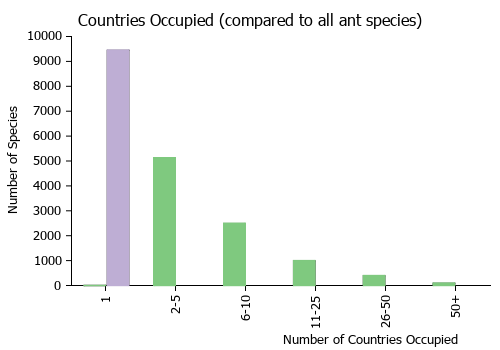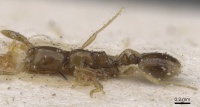Syllophopsis elgonensis
| Syllophopsis elgonensis | |
|---|---|

| |
| Scientific classification | |
| Kingdom: | Animalia |
| Phylum: | Arthropoda |
| Class: | Insecta |
| Order: | Hymenoptera |
| Family: | Formicidae |
| Subfamily: | Myrmicinae |
| Tribe: | Solenopsidini |
| Genus: | Syllophopsis |
| Species: | S. elgonensis |
| Binomial name | |
| Syllophopsis elgonensis Santschi, 1935 | |
Nothing is known about the biology of Syllophopsis elgonensis.
Identification
Bolton (1987) - M. elgonense is separated from Syllophopsis jonesi and Syllophopsis thrascolepta by its shorter scapes, from the Rwandan Syllophopsis sersalata and the west African Syllophopsis malamixta by its smooth mesopleuron, from Syllophopsis modesta by its deeply impressed metanotal groove, and from Syllophopsis cryptobia by being larger and having the propodeum produced into an acute peak behind the metanotal groove. At present elgonense is known only from Kenya.
Keys including this Species
- Key to Afrotropical Erromyrma, Monomorium, Syllophopsis and Trichomyrmex species
- Key to Afrotropical Syllophopsis
- Key to Afrotropical Syllophopsis hildebrandti group species
Distribution
Latitudinal Distribution Pattern
Latitudinal Range: 0.24° to -0.317°.
| North Temperate |
North Subtropical |
Tropical | South Subtropical |
South Temperate |
- Source: AntMaps
Distribution based on Regional Taxon Lists
Afrotropical Region: Kenya (type locality).
Distribution based on AntMaps
Distribution based on AntWeb specimens
Check data from AntWeb
Countries Occupied
| Number of countries occupied by this species based on AntWiki Regional Taxon Lists. In general, fewer countries occupied indicates a narrower range, while more countries indicates a more widespread species. |

|
Estimated Abundance
| Relative abundance based on number of AntMaps records per species (this species within the purple bar). Fewer records (to the left) indicates a less abundant/encountered species while more records (to the right) indicates more abundant/encountered species. |

|
Biology
Castes
Nomenclature
The following information is derived from Barry Bolton's Online Catalogue of the Ants of the World.
- elgonensis. Syllophopsis elgonensis Santschi, 1935b: 267, fig. 4 (w.) KENYA.
- Type-material: holotype worker.
- Type-locality: Kenya: Mt Elgon, east slope, camp 1, st. 13, 2100 m., 1932-33 (R. Jeannel & P.A. Chappuis).
- Type-depository: MNHN.
- Combination in Monomorium: Bolton, 1987: 422;
- combination in Syllophopsis: Ward, et al. 2015: 73.
- Status as species: Ettershank, 1966: 101; Bolton, 1987: 422 (redescription); Bolton, 1995b: 261; Hita Garcia, et al. 2013: 212; Sharaf & Aldawood, 2013a: 82 (in key).
- Distribution: Kenya.
Unless otherwise noted the text for the remainder of this section is reported from the publication that includes the original description.
Description
Worker
Bolton (1987) - TL 1.9-2.0, HL 0.48-0.51, HW 0.40-0.43, CI 80-84, SL 0.36-0.39, SI 90-95, PW 0.29-0.30, AL 0.56-0.60 ( 8 measured).
Eyes of a single ommatidium, maximum diameter 0.05-0.07 x HW. Antennal scapes relatively short, SI < 100. Promesonotal dorsal outline evenly rounded in profile, the metanotal groove conspicuously impressed. In profile the propodeal dorsum immediately behind the groove with a small peak, which appears as a weak transverse crest in dorsal view. Propodeal dorsum behind this peak sloping posteriorly to the pair of short broad denticles or prominent triangular angles which mark the junction of dorsum and declivity. All dorsal surfaces of head and body with numerous short hairs and very sparse pubescence. Propodeum with only 1-2 pairs of hairs. Pubescence on sides of head behind eyes decumbent to appressed, that on the antennal scapes more elevated but not erect. Unsculptured everywhere except for scattered minute hair-pits, and some faint striation on the bullae of the metapleural glands; lower halves of mesopleuron smooth and shining. Colour uniform yellow.
Type Material
Bolton (1987) - Holotype worker, Kenya: Mt Elgon, camp 1, st. 13, 2100 m, 1932-33 (Jeannel & Chappuis) (Musee National d'Histoire Naturelle) [examined].
The holotype is much abraded and densely coated with old glue which obscures the pilosity and some of the surface detail.
References
- Bolton, B. 1987. A review of the Solenopsis genus-group and revision of Afrotropical Monomorium Mayr (Hymenoptera: Formicidae). Bulletin of the British Museum (Natural History). Entomology. 54: 263-452.. (page 422, Combination in Monomorium)
- Santschi, F. 1935b. Hymenoptera. I. Formicidae. Mission Sci. Omo 2: 255-277 (page 267, fig. 4 worker described)
- Ward, P.S., Brady, S.G., Fisher, B.L., Schultz, T.R. 2015. The evolution of myrmicine ants: phylogeny and biogeography of a hyperdiverse ant clade (Hymenoptera: Formicidae). Systematic Entomology 40: 61–81 (doi:10.1111/syen.12090).
References based on Global Ant Biodiversity Informatics
- Bolton B. 1987. A review of the Solenopsis genus-group and revision of Afrotropical Monomorium Mayr (Hymenoptera: Formicidae). Bulletin of the British Museum (Natural History). Entomology 54: 263-452.
- Ettershank G. 1966. A generic revision of the world Myrmicinae related to Solenopsis and Pheidologeton (Hymenoptera: Formicidae). Aust. J. Zool. 14: 73-171.
- Garcia F.H., Wiesel E. and Fischer G. 2013.The Ants of Kenya (Hymenoptera: Formicidae)Faunal Overview, First Species Checklist, Bibliography, Accounts for All Genera, and Discussion on Taxonomy and Zoogeography. Journal of East African Natural History, 101(2): 127-222
- Santschi F. 1935. Hymenoptera. I. Formicidae. Mission Scientifique de l'Omo 2: 255-277.
- Sharaf M.R., Aldawood, A.S. 2013. First occurrence of the Monomorium hildebrandti-group (Hymenoptera: Formicidae), in the Arabian Peninsula, with description of a new species M. kondratieffi n. sp. Proceedings of the Entomological Society of Washington 115: 75-84 (doi:10.4289/0013-8797.115.1.75).

